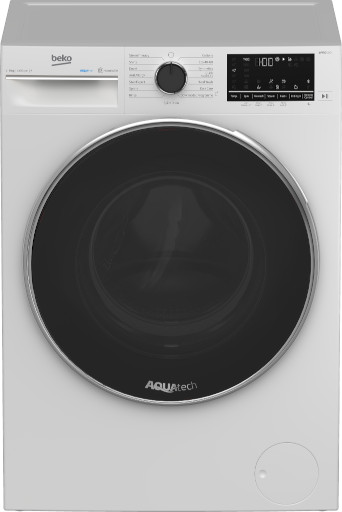Why is my washing machine not rinsing/draining properly?
There are several reasons why your washing machine won’t drain/rinse properly. It’s important to rectify the issue on your washing machine promptly as, if your washing machine isn’t draining or rinsing properly, your laundry won’t be cleaned correctly.

What causes a washing machine to not rinse properly?
Washing machines not rinsing is a common issue and usually means that the washing machine is not draining correctly. This is usually due to the washing machine drain hose being bent or stretched or the drain pump filter being blocked.
If you are still experiencing issues after following the instructions in our guide, please contact Beko’s Customer Service at 0333 207 9710 for assistance. We do not recommend that you try to repair the appliance yourself. Our expert support team will be more than happy to assist and organise technical assistance for you.
How to fix a washing machine that won’t drain/rinse?
Firstly, it is important to check that your drain hose is not extended past the maximum length quoted in the instruction book. You can find this information in your appliance manual. If you have misplaced yours, don't worry you can download your appliance manual.
When checking the drain hose, make sure the drain hose has not been crushed, kinked or twisted.
How to check the drain hose:
- Turn off the power supply to the washing machine and unplug it.
- Carefully pull the washing machine forward so you can access the drain hose.
- Ensure that the drain hose does not exceed the maximum length quoted in your instruction manual.
- Also, check that the drain hose has not been crushed, kinked or twisted or is blocked.
If the drain hose appears to be fine, you will need to clean the filter pump.
How to unblock the drain pump filter:
- Locate the filter on the bottom right-hand side of the appliance.
- When you open the filter housing there may be a large amount of water. If your appliance has a drain tube, you can use this to reduce the amount of water in the drum.
- Place a container under the filter to collect the remaining water. Be sure to open the filter housing slowly to avoid too much water being released in one go.
- Once the water has stopped flowing out you can then remove the filter.
- Cleaning the filter can be done by rinsing it under the tap.
- Once finished, make sure you replace the filter properly.
- If this does not solve the problem, please find out our contact details by clicking here.
Finally, if your Beko washing machine is having problems removing or retaining water from the drum, you should check that the drain pipe is correctly set up as if not this can lead to water siphonage. Here are some simple instructions that explain how to check your drain:
- Locate your washing machine’s drain pipe and the standpipe the waste water flows into. Please note washing machines are heavy, be careful when lifting and moving. We strongly recommend you have someone assist you when lifting, tilting and moving your washing machine.
- Make sure that the drain hose has not been inserted too far into the waste pipe. The maximum should be 15cm inserted, otherwise a vacuum may form which can cause siphonage.
- The drain hose should be connected to the standpipe at the correct height for it to work properly. Ensure the highest point of the water drain hose is a minimum of 40 cm and a maximum height of 100 cm from the floor.
Did we answer your question?
We are so sorry we were unable to answer your question. You might be able to find the answer you are looking for in the ‘Related Questions’ below. If your query is still unanswered, please head over to our Contact Us page for further assistance.
Search FAQ’s
Search or browse our frequently asked questions to find the answer to your query.

